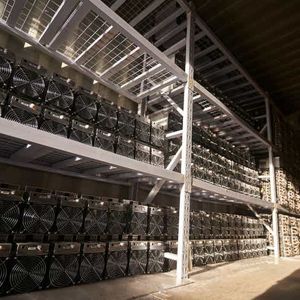

WGMI? A Sobering Look At Bitcoin Miners
Summary Bitcoin mining is a highly competitive industry with low barriers to entry and no ability to determine prices, making it difficult for publicly traded miners to outperform BTC. Publicly traded Bitcoin miners are likely to underperform the S&P 500's cash flow yield and may go to zero in the next 15 years if they don't make some changes. WGMI is an ETF that is heavily concentrated in top mining stocks. WGMI is good as a short term play on a continuation of the BTC rally. I expect issues over a multi-year time frame. Bitcoin (BTC-USD) mining has grown into an industry which receives a not infrequent amount of coverage in the media. For a long time, the energy cost of proof-of-work mining was viewed as a negative to the environment. Today that narrative is beginning to change for many good reasons. Bitcoin is concurrently growing into an asset class and socioeconomic concept which is gaining greater acceptance. As it does, it is likely that publicly traded Bitcoin miners will become a bigger field of investment analysis. This report covers the economics of Bitcoin mining and argues that most (if not all) publicly traded miners are doomed to the following: They are almost guaranteed to massively underperform BTC over any 6-year period They are highly likely to underperform the S&P 500’s cash flow yield. As a result, the stocks should underperform the S&P 500. They may outperform the S&P 500 if and only if the company partially becomes a Bitcoin holding company such that it is valued more by its balance sheet rather than its cash flows. They are likely to go to 0 in the next 10-20 years, or at least cease much of their current mining operations. A new type of publicly traded BTC miners may emerge as survivors, but these miners will be very different from today’s miners. They are completely dependent on the long-term acceptance, adoption, and utility of Bitcoin. This is the most certain point of all four. This report does not cover specific miners but looks at the state of the publicly traded portion of the BTC mining industry as a whole. Thus, the main asset I’m writing about is the Valkyrie Bitcoin Miners ETF (WGMI). Crypto fun fact: the ticker WGMI comes from the crypto acronym "WAGMI" which is short for "we're all gonna make it." This has been used as a way to endearingly poke fun at the high risk profile of crypto - the risk that in many instances, we are actually not gonna make it (ie. NGMI). Here, I'll answer the question regarding miners: Are WGMI? I am putting a Hold rating because the short and medium term may result in WGMI outperforming due to a high beta with BTC, but I am rather bearish for the long term. Let’s begin. Holdings and Expense Ratio WGMI is a pretty concentrated ETF. The top 10 are mostly miners and make up almost 84% of the portfolio. Nvidia ( NVDA ) is about a tenth of the portfolio, and it isn’t a mining stock, so it feels a bit out of place. WGMI Top 10 (Seeking Alpha) I think the 0.75% expense ratio is also high for something holding only 23 assets. It’s clear that we can analyze the ETF on the basis of the miners seen in this picture. And there’s a few things that all Bitcoin miners have in common. The Economics of Bitcoin Mining Let’s start by making something very clear: there is probably no other industry that is more perfectly competitive than Bitcoin mining. A perfectly competitive market is an economic term for markets with: Free entry and exit of firms; the barriers to do so are low Identical goods produced by each firm As a result of perfect competition, firms have: No ability to determine the price of the good; the market alone does that via supply and demand No economic profits. If the price of the good increases (again, this change will never be due to the decision of a firm), then more firms enter the market and increase the supply. If the price of the good decreases, then more firms exit the market and decrease the supply. This dynamic means that marginal costs will always equal marginal revenue. No firm can derive profits because margins all go to 0 in the long run. Now let’s look at Bitcoin mining. The only barrier to entry is to acquire machines (these are sometimes called “ASICs”) optimized for rapidly computing a SHA-256 hash and to procure an Internet connection and energy source to power these devices. The “good” produced by miners is hashes. The more hashes the miner can produce, the more revenue the miner will receive in the form of BTC, derived from transaction fees and block rewards. Miners expend their physical capital (mining machines) and some ongoing “COGS” (electricity and some manpower) to produce hashes. At no point can miners determine the market price of the hashes they produce – that number comes strictly from the supply and demand for hashes, which is a function of people using the Bitcoin network (demand) and how many miners there are (supply). (Just for clarity, we must note that it’s not that every hash is sold for BTC. Rather, most hashes are useless but because hashes are random numbers and the Bitcoin will reward only a certain type of hash, the more random hashes a miner can create means there is a higher chance one of those hashes will qualify for revenue. Thus, the rate of hash creation – or “hashrate” – is a core metric for Bitcoin miners.) This is an exceedingly simple business model, and it is trivial to see that the barrier to entry or exiting is almost non-existent and that a miner cannot differentiate its product (a hash is a hash, and they are all fungible). The “edge” when it comes to mining will come from two places: The cost of the electricity used to power the ASICs. Like all other firms, lower COGS means higher gross profit. The efficiency of the hashing machines. Newer machines have an advantage. It may be possible that some proprietary designs exist which give the miner an outsized advantage. Because of perfect competition and the mobility of mining, there will continue to be a race to find the cheapest power sources. Eventually, I expect Bitcoin miners to spread out to very remote locations, utilizing very cheap power sources. I first mentioned this in my article about Monero (XMR-USD) in which I updated my perspective about Bitcoin’s ASIC-friendly mining: [ASIC-dominance] creates a very curious incentive for Bitcoin miners that we are only recently beginning to observe en masse. Because Bitcoin can be trusted to never change, ASICs can be acquired and expected to have lasting value. Thus, the only remaining variable for miner profitability will be the cost of electricity. As such, Bitcoin miners will go seek out the cheapest sources of power available. They will even explore new sources of power that others have yet to consider. Mining gives such explorations an immediate source of revenue (note: not profit, but revenue) and a proof of concept. This is part of the reason why Bitcoin will be increasingly regarded as an ESG-friendly industry and asset, which will be a big pivot from the dominant narrative a few years ago. My focus is that because miners can trust that their ASICs will not be rendered useless, the only thing left for them to do is to seek out cheap power. And these spots can literally be located anywhere on Earth. This is a very compelling force for decentralization. Whereas my previous concern was that Bitcoin's hash rate is concentrated in a few ASIC mining rigs, I now see an overwhelmingly decentralizing force in the form of miners seeking out the cheaper power in their selfish and rational mission to maximize profits. Given the economics of Bitcoin mining, I even expect that large-scale mining rigs will eventually fade away in relevance as they lose their edge to smaller miners which are more mobile and able to capitalize on cheaper and cheaper sources of power. Perfect competition results in decentralization. More firms are producing goods, and no firm can influence the market price on its own. Critics have long pointed out that a few large mining rigs control a huge portion of the hash rate. If these were to be shut down by say a government, they argue, then Bitcoin would experience a sudden drop in security. While those are legitimate issues, they are not persistent issues. The long-term result of perfect competition in mining will be a decentralization of mining operations. They will rely on different energy sources, operate in different areas of the world, and their physical appearances and footprints may differ due to the environments they are in. Yet, they will all be producing the same good. This is great for Bitcoin as decentralized, hard money, but it is very bad for miner profitability. Only those who are shrewd enough to get to the cheapest energy sources will see consistent profits. The differentiator between miners as corporate entities and not only as mining operations will come from a few places: Does the miner hold some of the mined BTC? If so, then it needs to be valued based on those balance sheet assets as well. At that point, the business is really two businesses: a BTC holding company and a mining operation. Does the miner derive revenue outside of just mining BTC? Astute observers may note that some miners have received money from government entities for their assistance in stabilizing the local grid. That is additional revenue which should flow to the shareholders. There are also other external revenues, such as merge mining, which even less people are aware of. Evaluating mining companies as investments will require us to be aware of these factors. Both points are somewhat applicable to many publicly traded miners today. The question then becomes to what extent these other factors can subsidize the mining operation enough for the whole firm to be profitable. So far, the lack of profits in most of the big mining firms should be at least a partial answer to that question. The seven firms I depict here are all in the top 10 companies in WGMI. Miners Profitability (Seeking Alpha) The Economics of Bitcoin, Which Pertain to Miners Unfortunately for miners, BTC is the hardest money there has ever been thanks to its mathematical certainty. For example, BTC is much, much harder than gold because no one knows what the actual limit to gold is. Here’s a thought experiment to drive home the point. Let’s assume the spot price of gold triples tomorrow and people realize that this new price point is here to stay. Gold miners will work longer, buy more equipment, hire more workers, all to increase their rate of producing gold. Let’s say gold keeps going up so that it is 10, 20, or 100 times what it is now. At that point, there will be other businesses moving into the industry of obtaining gold. Someone will pitch an idea to VCs about going into space to mine asteroids. That idea will probably receive a good amount of funding. Someone else might have a way to synthesize gold in a lab. All these things are already possible to some extent, but they aren’t done because the price of gold right now in 2023 does not justify the cost of these other ventures. However, if the price of gold did shoot up, then these ventures would become profitable. And all these people trying to figure out how to get more gold will obviously cause the supply of gold to increase extraordinarily faster than before. Now let’s look at Bitcoin. Even if BTC’s price increased by a multiple of a trillion (yes, that is 10^9, let’s truly steelman this argument), the Bitcoin supply will not waver from its mathematically defined emission schedule. This is thanks to the difficulty adjustment, in which the network will adjust so that mining a new block will take 10 minutes on average, no matter how many miners are mining. This is of course great for being hard, sound money. It is very bad for miners, because it means that they are in a true zero-sum game. Gold miners have a much easier task than Bitcoin miners. There is gold in the ground and in outer space. There is gold that can be synthesized in a lab. The amount of gold truly out there is functionally unlimited. There will only be 21 million BTC, and the release of these coins is already predetermined by the Bitcoin code. This is unchangeable. Here’s the next question: if gold and silver miners underperform the commodity and these miners are not even playing a zero-sum game, why would BTC miners who are playing one of the most unforgiving zero-sum games do any better? GLD and GDX (Seeking Alpha) Points 1 & 2: Likely to Underperform BTC and the S&P 500 The fact that BTC mining is a zero-sum game is the core reason Bitcoin miners are nearly guaranteed to underperform BTC in any 5-year period. Why 5 years? The Bitcoin block reward halves every 4 years. This has always been bullish for BTC’s price, but it is an obstacle for miners because it means the zero-sum pie just got smaller for everyone. To make money mining, you must keep working, and the work gets harder and harder as the network grows (again, due to the difficulty adjustment). The odds are stacked against any individual miner, and this demand for constant work is partly what makes Bitcoin decentralized while things like Ethereum and Solana are not really decentralized because they run a passive proof-of-stake scheme. The Halving and the perfect competition impose a persistent negative tracking error upon a miner’s ROE. They need to find other sources of revenue to subsidize it, or they will certainly underperform BTC. These other sources of revenue are unlikely to subsidize mining operations. Historically, they haven’t. This is why the S&P 500 has positive earnings but basically none of the big publicly traded miners have positive earnings. Only MARA does not have massively negative ROE and some of them have millions of dollars in negative levered free cash flow. The Seeking Alpha comparison tool for profitability tells the succinct story. Miners Quant Factors (Seeking Alpha) Either way, these are companies which have a hard reckoning every 4 years, and another Halving is just weeks away. I don’t see miners being consistently profitable anytime soon, so I do not think they have good reason to outperform the S&P 500. Personally, I am staying away from miners and sticking to BTC. It’s just bad practice to invest in businesses without a moat. As investors, we’d prefer to own monopolies and oligopolies, not firms locked in perfect competition. Point 3: Likely to Go to 0, And the Possibility of Exceptional Survivors In fact, my expectation is that all the big miners today will go to 0 in the next 10-20 years unless they seriously change how their business works. Some miners may be able to pay down their debts, slowly liquidate their capital assets, and pivot to being a Bitcoin holding company with some level of financial services included. Perhaps they can lend out their coins or make a market for OTC covered call exotic products. Some miners might get bought out by other companies. Others may have to pivot to strategies where they are getting more revenue from non-mining sources. For example, as with the highly publicized case of RIOT receiving payments from the State of Texas, they might negotiate deals with municipalities to be compensated for supporting the energy grid. I think this might work for a bit, but it’s not a stretch for the next phase of using Bitcoin mining to support the grid is for households themselves to host mining machinery to get energy credits from the power company. This is aligned with what we’d expect from the decentralizing effect of perfect competition. Without a substantial pivot, the big miners of today will go to 0 in less than 20 years. Miners are already issuing tons of shares just to expand or maintain their mining competitiveness. None of them have generated consistent profits, and no informed investor will ignore the fact that even if the price of Bitcoin goes up, a given miner may still be unprofitable in the long term because perfect competition means that the miner’s share of the total network hash rate will decrease due to new entrants. Will there be a profitable mining-only business? I think it is possible. We just haven’t seen it yet in the publicly traded sphere. The business needs to be mobile and very adaptable. It must take advantage of seasonal or irregular changes, rapidly relocating to the cheapest power sources. It may have to operate across borders, and administrative tasks need to be taken care of in a lightweight and hyper-optimized manner. Revenue wasted on excessive SG&A work will be unacceptable. Such a business would be small by necessity, possibly a nanocap if it were ever listed. However, the ROE of a superbly mobile Bitcoin miner which can always go set up shop at the cheapest locations in a continent could be huge. As an investor, I would be on the lookout for any publicly traded miners that make pivots toward this kind of hyper-optimized, lightweight, and mobile operation. For some of the smaller ones, it may be possible to sell most of their ASICs, lay off most of the employees, pay down debts with the BTC or cash they have on the balance sheet, and then redesign their business around being more mobile. Point 4: Tied to the Fate of Bitcoin If Bitcoin fails, miners are done for. The only economically productive asset that miners own are Bitcoin mining ASICs. These machines are good for nothing but Bitcoin mining, so if Bitcoin fails, then everything the miners own will be worthless. There is no pivot where the miners can use the computers to do something else. Mining ASICs cannot do any computing other than the SHA-256 hash, so it is completely useless for stuff like AI or data center servers. I think the chance of Bitcoin failing is almost 0, but this report would not be complete without addressing just how tied to Bitcoin these miners really are. Gold mining is less tied to gold, as the machinery can probably be used for other things. What Are the Long Term Impacts of This? Given what I have laid out, it should be clear that Bitcoin's long term future is extremely robust and decentralized. If there had been any criticism in the past about big miners controlling a large portion of the hashrate, this concern will only diminish over time as diseconomies of scale catch up to bigger miners and hashrate becomes more and more decentralized. There is a saying in the Bitcoin industry that "no one has a monopoly on energy." This is commonly used to reference the fact that Bitcoin is truly a global currency because energy is the only requirement to participate in the network to earn BTC - and everywhere on Earth there are generally sources of energy if your look hard enough. Miner ROE would theoretically be something that approaches the risk-free rate plus a light risk premium over time. Because the industry is perfectly competitive, all economic profits will trend towards 0, so the most miners can expect to make is the risk-free rate plus a very light risk premium taking on some level of operational risks. This is why I think the publicly traded miners don't have a long-term future if they stay on the current path. Indeed, many of their present actions are starting to point to a realization of this fact. TeraWulf and Iris Energy are diversifying to AI and HPC capabilities. Riot is working with ERCOT to enhance the electric grid in Texas. These are all signals that miners understand they need to do more than just mine, because mining ROE alone is absolutely heading towards 0 in the long term. Will these companies still exist in 15 years? I think so, but I think their business operations will have changed significantly. Think of it as Amazon back in the day when it started as an online book store. There was no way to compete as a book store because the market was too competitive. So it gradually began to invest in AWS, which is where it makes most of its money today. If we glanced at Amazon's financial statements today, and if we assumed we had no knowledge of its history, would we recognize it as the book store it was 20 years ago? Big change is the only path forward for these big miners. As for smaller miners which are not publicly traded, these can probably thrive forever. If I can get a small amount of energy at almost zero cost, then I can of course mine BTC at a very large profit margin. This would keep my ROE high. But for physical reasons, I probably cannot easily reinvest back into the business since this whole thing was predicated on me locating a small amount of energy at almost zero cost. Once I am using all of that energy, I must find a new source somewhere else to expand my business, and that process will take more time, effort, and capital. What Other Sources of Revenue Can Miners Get? I already mentioned grid support as an external source of revenue. Here is a summary of how that works. The main issue miners solve is that electric grids need to be “stable” – it cannot have vastly different amounts of power going through them or it will get damaged. Because Bitcoin mining is as easy as turning on the machines, it is one of the most flexible energy consumers known to Man. Bitcoin mining can consume excess power during times when households are not consuming power. When households need power (such as during a heat wave) the miner can simply turn off its ASICs and let households use that power. In this way, the grid is clearly stabilized thanks to the presence of miners. An unstable grid becomes exacerbated with reliance on renewable energy. Renewable energy tends to have consistency issues: the sun isn’t always out, the wind isn’t always blowing, and sometimes even a hydroelectric dam can be dry. Bitcoin miners are the apt solution to a source of demand which is always able to offset any excess. It is a solution which solves real problems, hence the external revenue. A very related but separate issue is that Bitcoin can be used to bootstrap green energy development . Some green energy projects require proof of concept before anyone will invest in it. However, without a guaranteed way to generate some initial revenue, no one will take the risk to create a proof of concept. It is a bit of a chicken and egg problem. Again, this is where Bitcoin mining comes in. Because mining can turn a power source into an immediate source of revenue, it allows a proof of concept to become feasible, which will in turn unlock more innovation in green energy development. In this case, it isn’t necessarily true that mining is the main business, nor will it even be a permanent part of a fledgling green energy business. However, the ability for Bitcoin mining to kick off this process puts miners in a better light from a green energy and ESG perspective. This could lead to Bitcoin miners receiving carbon credits, which could be a separate source of revenue. Merge mining is another external source of revenue, although it is more connected to blockchain than carbon credits or grid support compensation. I first publicly talked about merge mining being important to the future of Bitcoin in a LinkedIn post : Merge mining allows miners to publish the result of trial and error work done on the main chain to earn the right to mine blocks on a merge mined chain. The merge mined chain will usually require less difficulty than the main chain. So let’s say that a Bitcoin miner found a hash that came in slightly above the target required to mine a block on Bitcoin (remember: the lower the target, the greater the difficulty). The miner cannot mine a Bitcoin block, but his hash might be lower than the target on a merge mined blockchain. Thus, the miner can publish his proof-of-work to the merge mined network to mine the next block on the merge mined chain, and earn some fees there. One example of merge mining is Dogecoin (DOGE-USD), which is merge mined with Litecoin (LTC-USD). This is the reason why the two blockchains have hash rates which move in lockstep . All Litecoin miners can also receive fees and block rewards from Dogecoin. Bitcoin merge mining will yield far more security because Bitcoin’s hashrate is unmatched. Rootstock is a smart contract blockchain which can run the Turing complete Ethereum Virtual Machine. It is merge mined with Bitcoin and has just over half of Bitcoin’s hash rate contributing to it, making it the most secure smart contract blockchain in the world, and the second most secure blockchain. Bitcoin miners who are contributing their hashes to Rootstock may earn fees on Rootstock, which are denominated in RBTC, a wrapped version of BTC that is backed by real BTC on the main chain via a federated 2-Way Peg. Merge mining will only be as profitable as the merge mined chains are useful. So far, Rootstock does not have many users or big protocols. This puts a structural limit on the fees that merge mining on Rootstock can generate. Conclusion In the future, I may look deeper into specific miners. Right now, BTC is a far more attractive long-term position than any BTC miner. If you want to play the Bitcoin miner space, then a long-short strategy based on certain metrics may be profitable. Look for miners who can utilize what was covered here to generate external revenue. I expect carbon credits and grid support to come up on more earnings calls. I honestly do not expect any of them to pivot to a mobile, mining-only operation. They are mostly too big and such a move will require a huge amount of capex. I rate WGMI a Hold. I think a trader can use it to play the BTC rally post-Halving, but I don’t see a long-term future if the underlying companies do not substantially change their business models. Short term: WAGMI. Long term: uncertain, possibly NGMI.











